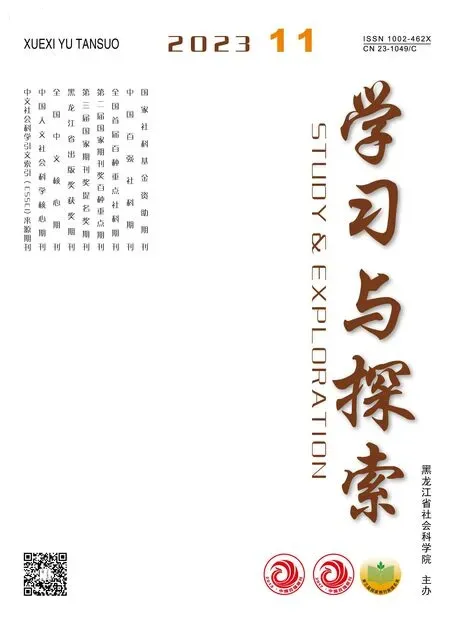ABSTRACTS
RequirementsoftheTimes,PracticalPrinciplesandPromotion PathsofSharedDevelopment
ZHANG Xi-hong, ZHANG Xin
(SchoolofPoliticsandLaw,NortheastNormalUniversity,Changchun130117,China)
Abstract:Shared development, an essential component of the new development philosophy, is both an important strategy for resolving the main contradictions of Socialism with Chinese Characteristics in the New Era and an inevitable choice to achieve a Chinese path to modernization. Therefore, it is of great theoretical and applied significance for guiding socialist modernization construction to scientifically comprehend requirements of the times, clarify the relevant practical principles, and expand the promotion path of shared development. Shared development should actively respond to the principal contradiction in contemporary Chinese society and conform to requirements of the times of putting people first, emphasizing fairness and justice, and pursuing common prosperity. In practice, we should adhere to the value of people-orientation, the path of high-quality development, and the organic unity of universal benefits and reasonable differences, considering improving social mobility, promoting urban-rural integration and regional coordinated development, and promoting the equalization of basic public services as the entry points and promotion paths for shared development.
Keywords:Common Prosperity;Shared Development;People-centered;Fairness and Justice
FormationMechanismsandPreventiveStrategiesofCountySocialConflicts andDisputesundertheFrameworkof“Risk—conflict” CAI Yi-chen1, ZHOU Zhi-ren2
(1.SchoolofPublicManagement,InnerMongoliaUniversity,Huhhot010021,China; 2.SchoolofGovernment,PekingUniversity,Beijing100871,China)
Abstract:China has entered a risk society, with an increasing interaction between conflicts and risks, and the accumulation and transmission of social conflicts are constantly increasing, making it more likely to turn into public conflicts. Understanding the relationship between social risks, conflicts and public conflicts is an important prerequisite for grassroots governments to improve the prevention and resolution mechanism of social conflicts. Based on the collection and analysis of 60 county-level social conflict cases at home and abroad, this paper summarizes their main body, object, manifestation and function field, and constructs an analysis framework of “risk-conflict” for county-level social conflicts. In the “risk-conflict” analysis framework, social conflicts have two sources of social risk energy accumulation and risk perception construction energy, and may also be accompanied by conflict over interests and emotional disagreements to form conflicts in political and social fields. In order to effectively prevent and resolve county-level social conflicts, we should strengthen the source management of social risks to prevent them from turning into conflicts on the one hand, and strengthen direction guidance to prevent social conflicts from evolving into relevant fields of political stability on the other hand.
Keywords:County Society; Social Conflicts; Social Risk; Public Conflicts
AStudyontheImpactofHigh-qualityDevelopmentofIndustrial ParksonResourceAllocation
WANG Jian-xiu1a,HOU Dan-dan1b,ZHANG Guo-ye2
(1.ShanxiUniversityofFinanceandEconomicsa.SchoolofManagementScienceandEngineering,b.SchoolofBusinessAdministration,ShanxiUniversityofFinanceandEconomics,Taiyuan030006,China; 2.ShanxiProvincialDigitalGovernmentServiceCenter,Taiyuan030031,China)
Abstract:Improving the efficiency of resource allocation is of great significance for promoting the high-quality development of China’s economy. As a typical location-oriented policy in China, industrial parks play an important role in promoting the free and orderly flow of various types of resources, as well as the efficient and fair allocation. Based on data of 287 industrial parks from 1993 to 2020, this paper constructs an evaluation index system for the high-quality development of industrial parks, and establishes theoretical and empirical models to test the impact of the high-quality development of industrial parks on regional resource allocation. The study finds that the high-quality development of industrial parks significantly reduces the misallocation of capital, labor and land resources in the region. Moreover, this impact exhibits heterogeneity based on factors such as the park’s level, development period, and geographical location. From the perspective of long-term cumulative effects, the improvement of the level of high-quality development of industrial parks will lead to a continuous decrease in the misallocation of capital, an initial increase and then a decrease in the misallocation of labor, and a decrease and then an increase in land misallocation in the region. From the perspective of spatial effects, the high-quality development of industrial parks has spillover effects on the resource allocation of neighboring regions. The research findings of this paper have important implications for promoting the management of industrial parks and improving the efficiency of resource allocation.
Keywords:Industrial Parks; High-quality Development; Resource Misallocation; Long-term Cumulative Effects; Spatial Spillover
Mimesis:TheoreticalOriginsandPreviousPracticesofCreativeWriting
ZHANG Yong-lu,CHEN Zhi-yuan
(ChineseCreativeWritingResearchInstitute,ShanghaiUniversity,Shanghai201900,China)
Abstract:Mimesis is an important component of Creative Writing Theories, which originated from concepts of mimesis in ancient Greece and Rome and pedagogies of imitation in aristocratic education. In the domain of Creative Writing, after reviewing classical concepts of mimesis represented by Plato and Aristotle, it is not difficult to find that the two philosophers have respectively formed two different paradigms: the imitation of objects and the imitation of behaviors in writing. Ideal imitation is creation. In practice, the aristocratic education in ancient Greece and Rome generally adopted pedagogies of imitation and developed mature model training methods such as exercises of imitative writing, translation and interpretation. This not only confirms that classical imitation theories have nurtured valuable ideas of writing and principles and methods in imitative pedagogies as important guides in Creative Writing workshops, but also helps to clarify the dialectical integration between imitation and innovation in Creative Writing and provide legitimacy for the historical roots of Creative Writing Theories.
Keywords:Mimesis; Imitative Pedagogy; Creativity; Creative Writing
[英文編校:宋琳琳]

